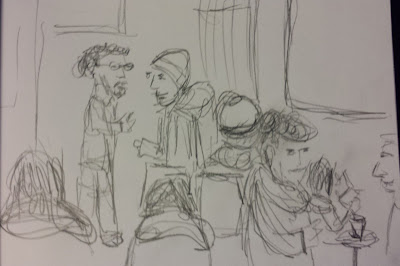The Minnesota Department of Transportation (MnDOT) had proposed in early 1992 to do a massive rebuild of interstate 35W through south Minneapolis. Talk about rebuilding the freeway started not long after the highway was finished in the first place, in the 1960's.
In May of 1992, MnDOT presented several options, asking for feedback on them. Their plan was to construct one of those options, which were all pretty similar. They all called for widening the freeway by taking houses in both the Windom and Phillips neighborhoods. The options varied from taking hundreds of houses to taking around a hundred. All the options also called for a stacked freeway where 35W and 94 come together.
A public hearing was scheduled on those options. It was to take place at the Richfield High School, a place not very accessible to transit, though I took the bus there to get to the shoot, which meant that I walked several blocks to get to and from the High School.
The day before the hearing, groups opposed to the plan held a rally at Franklin Steel Park in the Elliot Park Neighborhood. The park sits right beside the freeway. I went there because I was filming all kinds of things happening in the Phillips Neighborhood, where I lived, and wanted to film this too. I filmed the speakers and also did some interviews.
I also went to the public hearing, but did not stay for the entire thing. It went until 2:30 the next morning. Rather than get a seat in the auditorium, I walked around to get interviews, film the media, and step in now and then in the gymnasium of the high school, where the hearing was being close circuit televised for an overflow audience.
I filmed an interview with a MnDOT Project Manager. I'm not sure what he thought of me with my small Hi8 camcorder, but he did do the interview for me.
At the time I thought I might do a documentary that looked at transportation in Minneapolis, and especially the disinvestment in public transit since the 1950's. Where the freeway now ran there used to run a very extensive streetcar system. That was long gone and people opposed to the freeway expansion were asking for light rail in the corridor instead of more freeway lanes. Around that time I did some filming of historic photos of streetcars to make this longer documentary project, but I never did. I filmed and edited other things and the tapes from these two shoots just sat in a box.
Now in 2018 35W is being reconstructed through the Phillips Neighborhood. Some houses were taken for this final plan, but nothing like the number of houses that were proposed to be demolished in 1992.
Light Rail Transit is not being built in that corridor, but a Bus Rapid Transit line is. That BRT line was give the green light for the federal share of its funding on the day that I finished this edit of this public hearing that happened 26 years ago.







